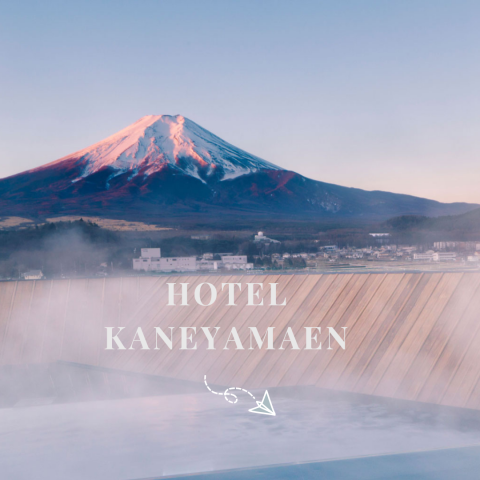Main content starts here.
Yamanashi is known as the fruit kingdom of Japan, and there's a good reason for that. Many fruits are grown in the prefecture, but this traditional agricultural lifestyle may be disappearing. To learn about the importance of farming in the region and see how tourism can revive the area’s agricultural industry, we took a trip to the Koshu area of Yamanashi. Here’s what we saw:
Mr. Buzawa’s Farm
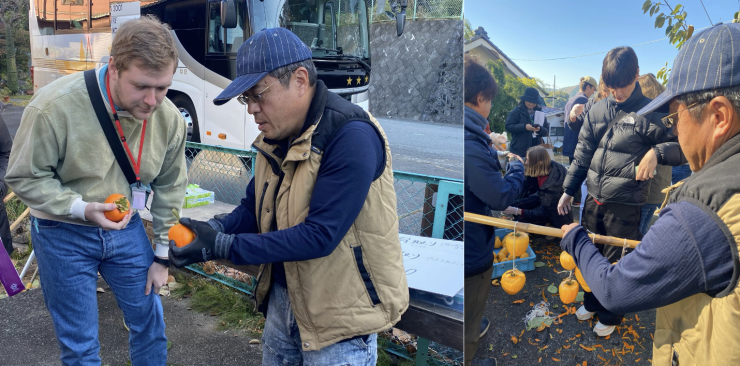
▲Mr. Buzawa teaches us how to cut the persimmon to help with the drying process (left). ▲Peeled persimmons are hung counterbalanced on a rod by strings for drying (right).
Mr. Buzawa is a local civil servant and farmer who lives in the Koshu area, and every year he harvests his persimmon trees in early November. Though he’s only recently begun inviting visitors to his farm, Mr. Buzawa hopes that agro-tourism will help preserve the farming industry in Koshu for years to come.
For international visitors, the language barrier makes the tour hard to fully understand; however, Mr. Buzawa’s high standard of hospitality made sure we all enjoyed our visit. He had graciously woken up early that morning to write cue cards in Japanese and English for us to follow along.
During the tour, Mr. Buzawa and his staff taught us how to pick the persimmons off the tree using different tools: a traditional bamboo rod, hand pruners, and a modern version of the bamboo rod. They showed us how the T-shaped stem left at the top of the fruit is used to aid in hanging it from the drying rods.
Once we had picked our persimmons, Mr. Buzawa showed us how to cut around the top stem, under the leaves, which allows for better airflow and drying of the persimmon. We watched as he instructed us how to peel the outer skin off. They are then hung from a bamboo rod so air can circulate as they dry. It takes about a month and a half for persimmons to fully dry, and Mr. Buzawa encouraged us to return to the farm in December to give them a try.
After we finished harvesting persimmons, Mr. Buzawa welcomed us to sit around a campfire and share a snack of roasted sweet potatoes and ripened persimmons as we watched a video about the region’s unique fruit cultivation system which recently became a UN recognized Globally Important Agricultural Heritage System (GIAHS). It was a sweet reward after harvesting in the morning chill.
We listened to how the local government has been working with farmers to ensure that Yamanashi doesn’t lose its agricultural traditions while making sure the farmers are able to make a living off of the products they sell. Part of the attempt for this is having visits from farmers to teach about their craft as well as visits to farms themselves to experience farming firsthand just like we did with Mr. Buzawa.
Moshi Moshi House
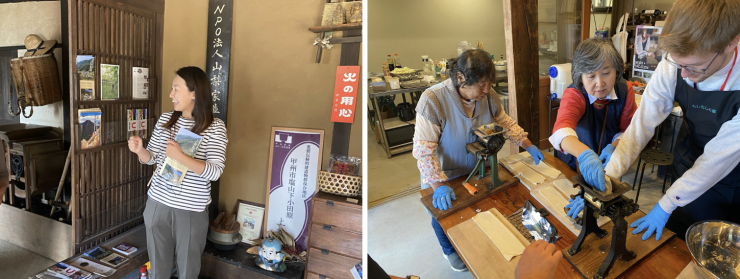
▲Ms. Uchida shares the history of the first village phone in the traditional genkan (entryway) of the Moshi Moshi house (left).
▲ Local women are helping feed dough into the pasta maker to make Houtou noodles (right).
At midday, we visited a house in Kamijo Village known as the Moshi Moshi House. “Moshi Moshi” is a Japanese phrase used when answering the phone, much like English speakers say “hello.” This traditional thatched home was the first in the village to have a working telephone, and neighbors would come to the house to call their friends, relatives, or anyone they could.
Ms. Uchida, the manager of Moshi Moshi house, and three senior community leaders greeted us when we arrived. They hope to teach others about the village’s history and pass it on, so that its value will not be lost in the generations to come.
One of the lessons they shared is how to make Houtou, Yamanashi’s signature dish. Houtou is a soup made with miso paste, seasonal vegetables, and thick noodles made of flour and water.
The women were skilled at overcoming the English language barrier by using hand gestures to demonstrate how to mix, knead, and feed the dough through the pasta machine. They even let us in on a secret tip: the pasta dough should feel similar to your earlobe.
After we finished prepping the noodles, they were cooked in a pot with locally grown vegetables and broth. Then we all gathered in the Moshi Moshi house to share the meal we had made together in the new community we had formed with each other.
Daizen-ji Temple
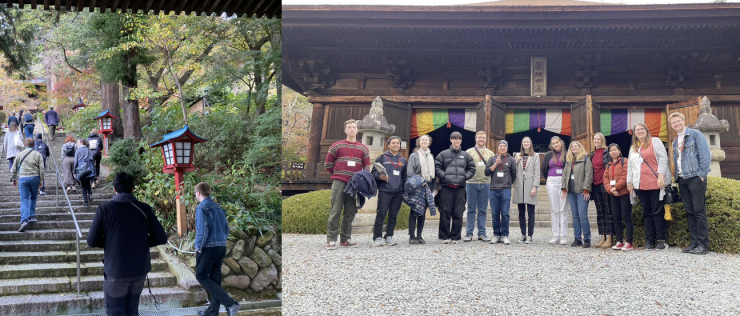
▲Walking up the steps to the Daizen-ji Temple (left).
▲Group photo taken outside the Daizen-ji Temple (right).
After we said goodbye to the women at Moshi Moshi house, we headed to Daizen-ji Temple. Before exploring the temple, we had a brief discussion of its history and how it relates to the agricultural industry in Yamanashi.
The temple is largely believed to be the start of grape growing in Japan. This stemmed from a Buddhist monk having a vision of the Buddha of medicine holding grapes. The monk carved a statue of this image, which can be seen every five years at the temple during the Katsunuma grape festival in October. It was just shown last year in 2023, so the next time visitors can see it will be in 2028.
The monk then went on to grow grapes and taught the locals how to use them for medicine. Eventually, this led to the other grape products of the prefecture. While at the temple, visitors can even enjoy some grape juice and wine. After learning the temple’s history, we explored the temple, which is particularly beautiful in fall, and looked out over the basin below before we continued on our journey.
Miyakoen Museum
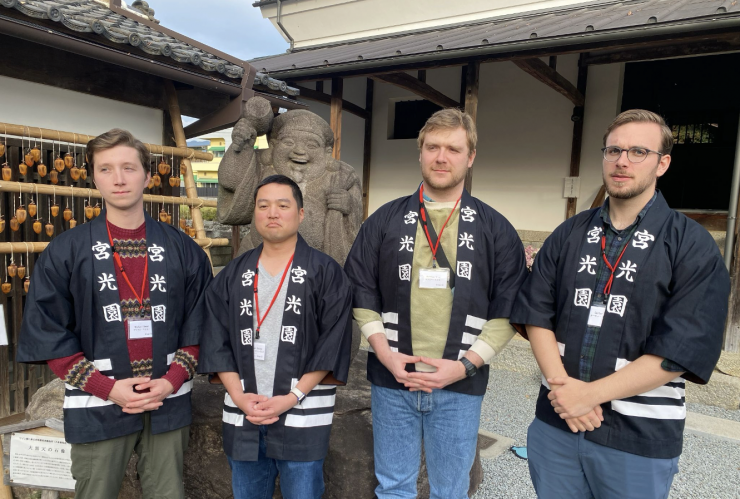
▲Striking a “serious” pose with Daikokuten, the god of fortune and wealth who inspired the winery's name, we don’t look too happy wearing our traditional 'happi' coats.
The Miyakoen Museum is on the spot where the first successful winery in Japan was built. Kotaro Miyazaki started the Daikoku Budoshu winery in the early 1890’s after the first private winery established in Yamanashi failed. He took over the building and tools to start his own wine-making business and cultivated a path for the wine industry we know in Yamanashi today.
We were told how some early pioneers even traveled to Europe to learn more about the craft, hoping to make wine a staple of Japan. As we walked through the museum, we saw relics of how wine was advertised and stored. The museum had old wine bottles, posters, and other relics encased in glass to commemorate where the wine industry started.
When we finished our tour, some of us tried on the clothing item called 'happi', which is worn at the local festival with the Daizen-ji Temple, and stood with the lucky god located in front of the museum.
Château Mercian
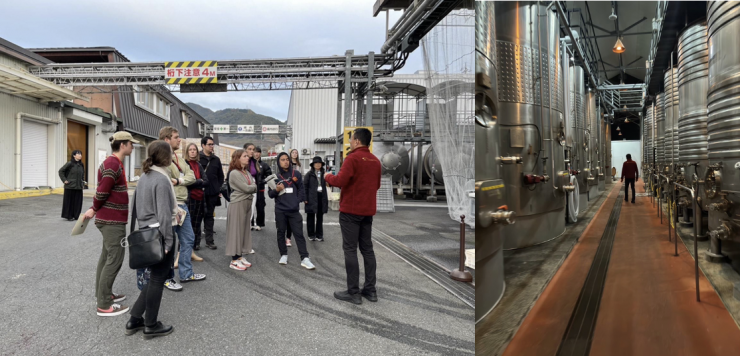
▲Mr. Ishikawa, our tour guide, teaches us about wine storage (left).
▲A view of storage drums inside of the winery (right).
Château Mercian is the present name for the winery founded by Kotaro Miyazaki, as it combined with two other wineries later on in its life. It’s just a short walk from the Miyakoen museum. We walked through the factory and saw the different processes used to make the wine, whether it was made in steel drums, wooden drums, or traditional small wooden barrels. How the wine is stored and how long it is stored impacts the quality and flavor.
The tour also covered the history of winemaking, and the old processes of smashing grapes to extract the juice. We even went into the storage area, which is always cold, no matter how hot it is outside, even in the Japanese summer. There they used to make “sweet wine” which was very popular in its time. However, this wine is no longer made due to the demand and growth that Japan has established with the Western-influenced variety.
Though the grape season was over for the year, we were still able to see how the winery receives, sorts, and uses the grapes after they are brought in from local farms in the area. We were also shown how Japan uses pergolas to grow grape vines rather than the trellis method typically used in Western countries. This allows better air flow in Japan’s high humidity. However, Mercian has both at its location.
The tour finished with a wine tasting. As we tasted two varieties, our guide described their flavors and what created their distinct tastes. One of the wines was unique to the area because the grapes come from a farm that is near a river/marshy area. This impacts the taste, making it different from wines that are made from grapes grown in drier environments.
At the end of the day, we all returned home with a higher knowledge of and appreciation for Koshu history and agriculture.
More Info
Moshi Moshi House(もしもしの家)
Address: 1099 Enzanshimoodawara, Koshu, Yamanashi 404-0025
Website (EN) : https://koushu-minka.jp/e-index/e-moshimoshi/
Daizen-ji Temple(大善寺)
Address: 3559 Katsunumacho Katsunuma, Koshu, Yamanashi 409-1316
Hours: 9 AM – 4:30 PM (last entry at 4 PM)
English Info: https://www.yamanashi-kankou.jp/english/recover/daizenji-temple.html
Miyakoen Museum(宮光園)
Address: 1741 Katsunumacho Shimoiwasaki, Koshu, Yamanashi 409-1313
Hours: 9 AM – 4:30 PM (last entry at 4 PM)
English Info: https://www.yamanashi-kankou.jp/english/uncover/miyakoen.html
Entrance fee: 200 yen
Château Mercian(シャトー・メルシャン)
Address: Katsunumacho Shimoiwasaki, Koshu, Yamanashi 409-1313
Hours: 10 AM - 4:30 PM
Website (EN) : https://chateaumercian.com/en/our-wineries/katsunuma/index.html
Published on
- February 7, 2024
Share
-
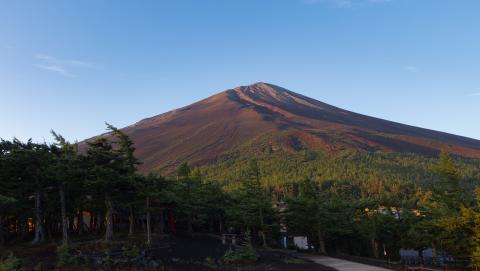
Fuji Subaru Line 5th Station & Mt. Fuji Travel Guide
March 3, 2025
ホーム > The Fruits of Labor in Yamanashi’s Koshu Region
